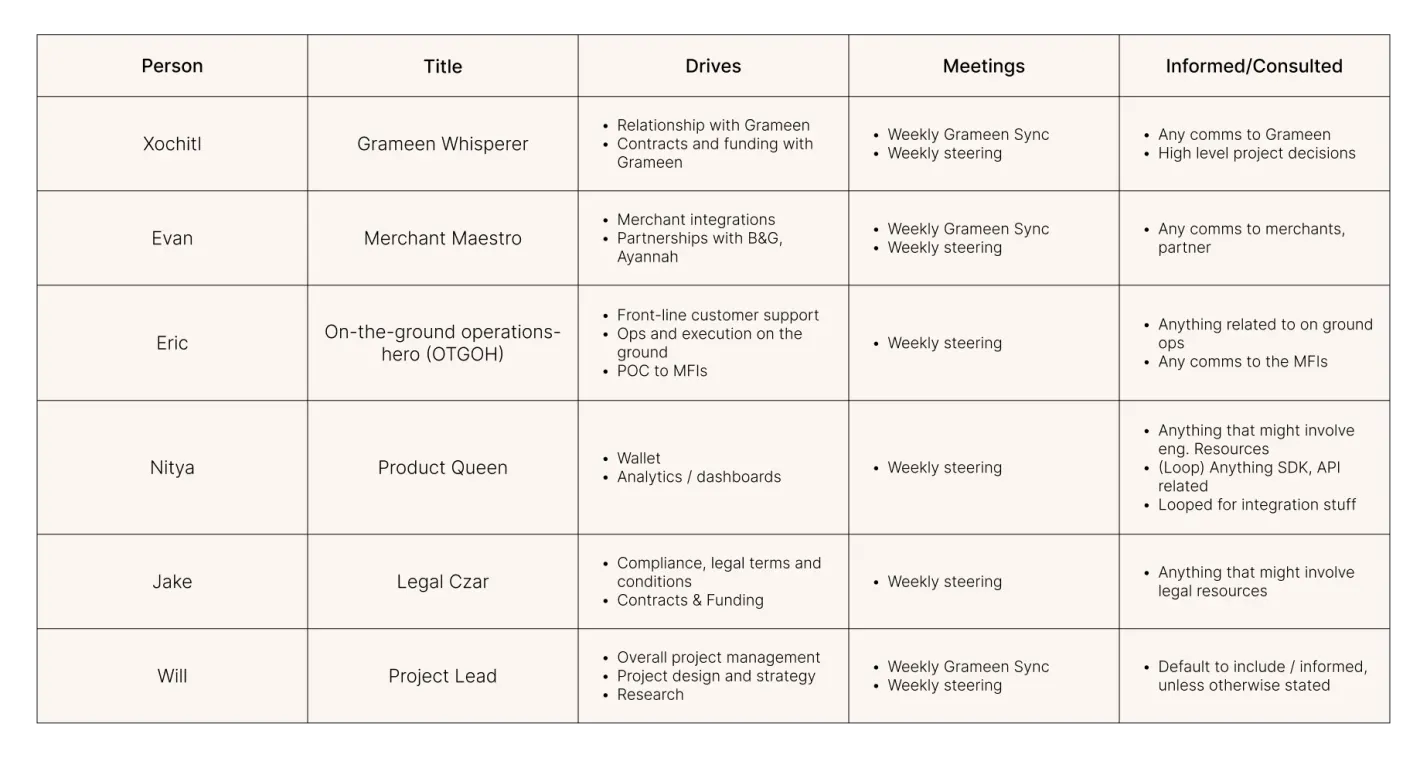Set Up Overview
Now that you’ve scoped out your pilot - meaning you’ve defined the objectives and sketched out the design. Now that the project has kicked off, there is a lot of preparation that must happen before your first touchpoint with pilot participants. Phase 3 covers this set-up phase. In a traditional pilot, this encompasses all the preparation leading up to your pilot launch.
Defining roles and responsibilities
We recommend clearly establishing roles and responsibilities, setting a meeting cadence, and establishing communication norms at the onset of a project. This becomes even more important as the complexity of pilots scale.
For instance, a recent COVID Relief project in the Philippines required the collaboration of 8 different Alliance for Prosperity members and several internal teams. It would be unwieldy to engage all parties in every meeting. In our kickoff meeting, we had a discussion of who needed to know what at different times. There are different frameworks you could use - we recommend RACI.

Example Roles and Responsibilities of Internal Team: We updated these as the project evolved
Tasks and Timelines
Executing a pilot can be a complex undertaking - hence the need to establish some tool to track tasks and deadlines. There are several tools you can use; at the Celo Foundation we’ve used Asana, Airtable, Notion, and old-fashioned spreadsheets. You should find the one that best suits your teams’ needs.There are numerous resources available for folks about project management, so we won’t go into too much detail here. However, here are some tips that we’ve found helpful in our past pilot work.
Start with what you know, plan backward. Is there a specific deadline you need to meet? When does the project need to be complete? Figure out your end dates and understand the steps required to hit those deadlines to inform your project plan.
Identify the critical path(s). Most projects will have dependencies across several workstreams. For instance, you will need to select participants and create an interview guide before you can speak with participants. Identify the ‘longest poles in the tent’ to see which initiatives are crucial to the success of your timelines.
Identify risks and mitigants. One thing we like to do with various stakeholders is to ask “what could possibly go wrong.” Having a view of all the potential risks and a tentative plan to address them ensures that there will be no last-minute surprises.
Flow of Funds
Now that you are in the planning phase, it could be helpful to revisit your flow of funds to make sure that the entire process is buttoned up. This is also an area where you may want to have a legal review, as money transmission can be sensitive in many jurisdictions.Some of the considerations in setting up your flow of funds:
Open or closed loop: Is the pilot structured as invite-only or otherwise a self-contained closed group? or does it allow people to interact in the wider society/economy?
On-ramps: How will participants get cUSD / CELO? What cash-in and cash-out (CICO) solutions are available in your geo/location?
Liquidity: Do on/off-ramp providers have a relationship with liquidity providers (e.g. market makers) or will they source liquidity from an exchange?
Custody: How will participants store and secure their funds?
Off-ramps: How will they use their funds? Merchants, cash-out, etc
Lost funds: What happens if funds are lost? Is there a contingency plan? Will you reimburse participants?
Legal Checklist
Legal reviews are a helpful check to make sure that you are fully compliant throughout the process. This becomes even more important with larger pilots or pilots that deal with vulnerable groups. Some questions you might want to ask yourself:
Do you have clearance, if needed, to pilot in the jurisdiction that you choose (e.g. is cryptocurrency regulated in your area?)
Have you met the requirements around Know-Your-Customer / AML?
Have you collected informed consent from pilot participants?
Have you collected consent for photos / videos / audio etc.?
Do you have a policy around data security and data sharing agreements, if needed?
There’s no need to recreate the wheel - we’ve included some example Terms and Conditions that you should feel free to leverage for your own work.
Hiring Local Support
In nearly all of our pilots, we’ve hired a local consultant (or two) to help with on the ground logistics, translations, and other miscellaneous tasks. This person is especially crucial in the planning phase - before your team arrives in country it is helpful to have someone on the ground prepare the pilot.If you decide to hire local support, feel free to use the following tools that we’ve developed.